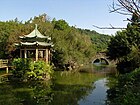달다리
Moon bridge | |
| 조상 | 아치교 |
|---|---|
| 들다 | 보행자 |
| 재료 | 돌, 벽돌, 나무 |
달다리(月橋)는 아치형 보행자 교량이다.달다리는 중국에서 유래되었고 후에 일본에 소개되었다.[1][2][3]
이런 종류의 다리는 원래 보행자들이 운하를 건널 수 있도록 설계되었고, 지하에는 바지선이 통행할 수 있게 되었다. 등반과 하강을 이용하여 시공할 경우 교량 접근을 위해 인접한 들판의 공간을 사용하지 않는 장점이 있다.
정식 정원 설계에서는 달다리를 두어 잔잔한 물에 반사되도록 한다. 높은 아치와 그 반사는 달을 상징하는 원을 형성한다.
솽시 공원과 중국 가든 타이베이
저녁에 호수에 비친 다리 (Dunedin Chinese Garden)
일본 도쿄 고이시카와코오라쿠엔의 엔게쓰쿄 석교 모양과 반사로 전체 원이 형성돼 있다.
참고 항목
참조
- ^ Boults, Elizabeth; Sullivan, Chip (2010). Illustrated history of landscape design. Hoboken, NJ: J. Wiley. p. 118. ISBN 978-0-470-28933-4.
- ^ Ono, Kenkichi; Edwards, Walter. "full-moon bridge 偃月橋・円月橋". Japanese Garden Dictionary: A Glossary for Japanese Gardens and Their History. Retrieved 2 September 2011.
- ^ Bernal, Peggy Park (1999). The Huntington Library, Art Collections, and Botanical Gardens. San Marino, California: Huntington Library. p. 23. ISBN 9780873281348.
Moon bridges were a feature of Chinese garden architecture, adopted by the Japanese in the thirteenth century. The large, rounded bridge is usually known as a moon bridge because the arch and the reflection in the water below form a full form a full moon shape, and also because “moon viewing” from beneath the bridge was a diversion for estate owners cruising on their private lakes.
| 위키미디어 커먼즈에는 문 브리지와 관련된 미디어가 있다. |





